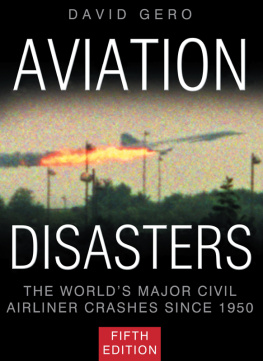AIRWORK
AIRWORK
A HISTORY
KEITH MCCLOSKEY

For my daughters
Amelia, Camilla, Laura
Cover illustrations. Front, top: AS.4 Ferry G-ACFB (via Peter Amos);
front, below: A Vickers Viking at the Gatwick open day, 10 July 1948
(Royal Aero Club). Back: Spitfire F.22s and a de Havilland Hornet at
Gatwick, c. 1952 (Tom Pharo via Air Britain)
First published in 2012
The History Press
The Mill, Brimscombe Port
Stroud, Gloucestershire, GL5 2QG
www.thehistorypress.co.uk
This ebook edition first published in 2013
All rights reserved
Keith McCloskey, 2012, 2013
The right of Keith McCloskey to be identified as the Author of this work has been asserted in accordance with the Copyrights, Designs and Patents Act 1988.
This ebook is copyright material and must not be copied, reproduced, transferred, distributed, leased, licensed or publicly performed or used in any way except as specifically permitted in writing by the publishers, as allowed under the terms and conditions under which it was purchased or as strictly permitted by applicable copyright law. Any unauthorised distribution or use of this text may be a direct infringement of the authors and publishers rights, and those responsible may be liable in law accordingly.
EPUB ISBN 978 0 7524 9459 3
Original typesetting by The History Press
CONTENTS
38 University Air Squadrons &
Britannia Flight
FOREWORD
The story of Airwork and its numerous activities and undertakings is an extremely large one. So large, in fact, that many of the thirty-nine chapters in this book could be easily expanded into books in their own right. It is the story of the vision of two men, Alan Muntz and Nigel Norman, who saw that there was more to just flying planes for pleasure and taking passengers from one place to another. They were in the right place at the right time to capitalise on the huge public, commercial and military interest in flying, primarily by focusing on providing the facilities and opportunities for everything that was needed to get an aircraft into the air, from providing flying lessons to selling the aircraft to engineering support to even designing the airports they would use.
In interviews of former Airwork employees for this book (several in their eighties and nineties), time and again the same expression would be used: Airwork were a cut above the rest. The pride of Airwork employees, from the apprentices of 1930s Heston to the Airworkies of Saudi Arabia in the late 1960s and early 1970s, and the Thumrait Thuggies of the late 1970s, 1980s and 1990s in Oman, is quite apparent.

Frederic Alan Irving Muntz 18991982. (Mrs Nicolette Baring)

Sir Henry Nigel St Valery Norman 18971943. (Sir Torquil Norman)
Some areas are well covered and there is little to add; I have drawn on the works done in these areas with the kind permission of their authors. I have also uncovered previously unpublished information gained from former Airwork employees and the private papers of Alan Muntz, very kindly provided by his youngest daughter Mrs Nicolette Baring, to whom I am deeply grateful. Overall what I have tried to do is to put together the first published account of Airwork from its beginnings to the present day and to include employees in that account. The company still exists and continues (mainly in Oman), although it has more or less passed into history.
Airwork became Britains largest immediate post-war airline; in a different political climate to the one in which they operated in the post-war era (i.e. one which did not suffocate private enterprise), one can only guess at what they might have achieved and what form the company would be in today without the dead hand of the state hampering virtually their every move.
Airwork had always been an organisation that involved itself in the social side of aviation. This was prevalent at both Heston and Misr-Airwork. Perhaps not quite as grand as some of the Heston or Cairo evenings, the annual Airwork dinner dances held for employees at the various depots were very much enjoyed by staff. Sports were another area in which employees showed great enthusiasm, from the Airwork Renfrew football team of the 1940s to the Airwork Rhodesia football team in the 1960s. Airwork Rhodesia presented the air force with a trophy for six-a-side soccer to be played for each year.
The book is also a tribute to men who worked in arduous conditions overseas and whose feelings can be summed up by one Airwork employee, Tony Allen, in Saudi Arabia in the early 1970s, who said:
I have to say that I did get home sick and lonely at times despite having made many friends. On occasion, two or three of us would stroll down to the Airport terminal building on a sultry evening, with no alcohol we would take our Mirandas and Seven-Ups to the viewing veranda and wait for the weekly arrival of BOACs VC10, a little reminder of England. We would watch the unlucky ones disembark and the lucky ones make their way across the apron to the luxury of the airliner in its smart blue and white livery and the speedbird logo on the tail fin. To see it lift off and climb away in the dusty evening sky was a melancholy feeling and did nothing to alleviate home sick blues.
Keith McCloskey
Berkshire
ACKNOWLEDGEMENTS
I must firstly mention Mrs Nicolette Baring. Nicolette is the youngest daughter of Alan Muntz and she has given me complete access to her late fathers papers, diaries and photographs. Many mysteries were cleared up for me and this would have been a far lesser book without her kind and tireless help. I would also like to mention Louis Curl who has laid all the groundwork for an in-depth study of Airwork; John Hancock of Babcock International the guardian of what little remains of Airworks history; and Alan Holloway who has kindly given me full access to his late fathers (Sydney Holloway) remarkable photographs and unpublished manuscript of his autobiography The Prototype Man: A Profile of S.A. Holloway and his Aviation 19321992.
I would like to thank Jennifer Scanlan for permission to reproduce some of the Ecuador chapter, John Havers for permission to reproduce the 1947 Taif Mission section, and R.A. Scholefield for the Barton and Sabre repair material. I would like to specially mention Major General Angus I. Ramsay CBE DSO and the Beit Trust for full access to their archives and their very kind financial assistance in the preparation of this book.
I have been given photos and help on a number of chapters from Peter Amos, Maurice Wickstead, Malcolm Fillmore; also Paul Becker for help with his late fathers work for the Alan Muntz design team, Carole Brooks for her kind help with RUAC and Zimbabwe, Bryan Collins for the labyrinth of Airwork company history and Fison-Airwork, John Odlin, Peter Gray, Helen King and Ted Weinel. Also, Neil Aird, Geoff Ambrose, Norman Anyon, Martin Val Baker (Valentine Bakers grandson), Helen Balkwill-Clark, John Barnes, Rob Belcher, Sqn Ldr J. Blanche (RAuxAF Historian & Archivist), Peter Carter, Peter Casling, Tom Cooper, Madame Mimi Di Castro, Bob Crouden, Antoin Daltun, John Davis, Andrew Dawrant (Royal Aero Club), Ian Doig, Mike Draper, Karen Dunn (Crawley Observer), Allan Ellis, Peter Farrow, Anthony Fitzgerald, Barry Flahey, Peter Foster, Nick Gardner, Peter-Michael Gerhardt, Les Ginger, David Griffin, William Guinness (the son of Loel Guinness), Guy Halford-MacLeod, Mike Hamence, Peter Hamlin, Dave Hann, Reg Havers, Ian Hawkridge, Dave Homewood, Ray Hooper, Lester Hope, Rita Huggins (for her brilliant detective work), Tony Hyatt, Markham Jackson, G.A. Jones, Bjorn Larsson, Clive Laudham, Barry Leeming, Chrissy McMorris of The History Press, Dave Newnham, Sir Torquil Norman (son of Nigel Norman), Peter Norris, Robin Norton, Mike Phipp, Brian Powell, Bob Pugh, Eleanor Pulfer (Slough Museum), Douglas Revell, Air Vice Marshal Sir John Severne, Ray Shoebridge, John Skinner, Jonathan Smith (Archivist & Modern Manuscript Cataloguer, Trinity College, Cambridge), Peter Smith, Major Gary E. Sparks (Ret.), Brian Stead, Les Steel-Smith, Ron Tannock, Bill Taylor, Dennis Rusty Theobald, Iain Todd, Phillip Treweek, William Turnbull, Steve Twigg (Marketing Director, Capita Symonds), Bill Van Heerden, Guy Warner, Dave Welch, Tom Wenham, Martin Wieuest and Allan G. Williams.
Next page














